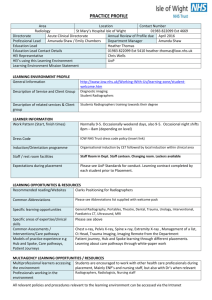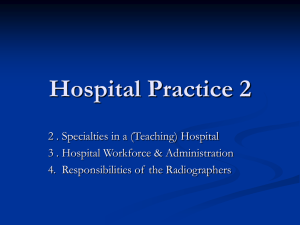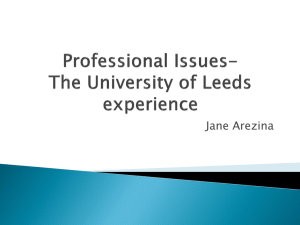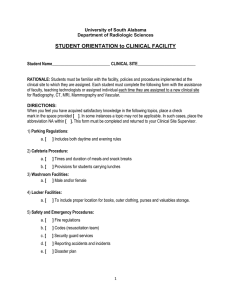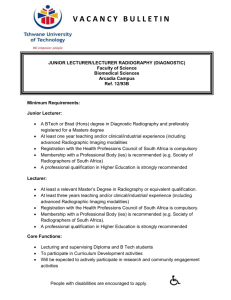ISSN: 2278-6236 A COMPARATIVE ANALYSIS OF THE EFFECTIVENESS OF COMMUNICATION
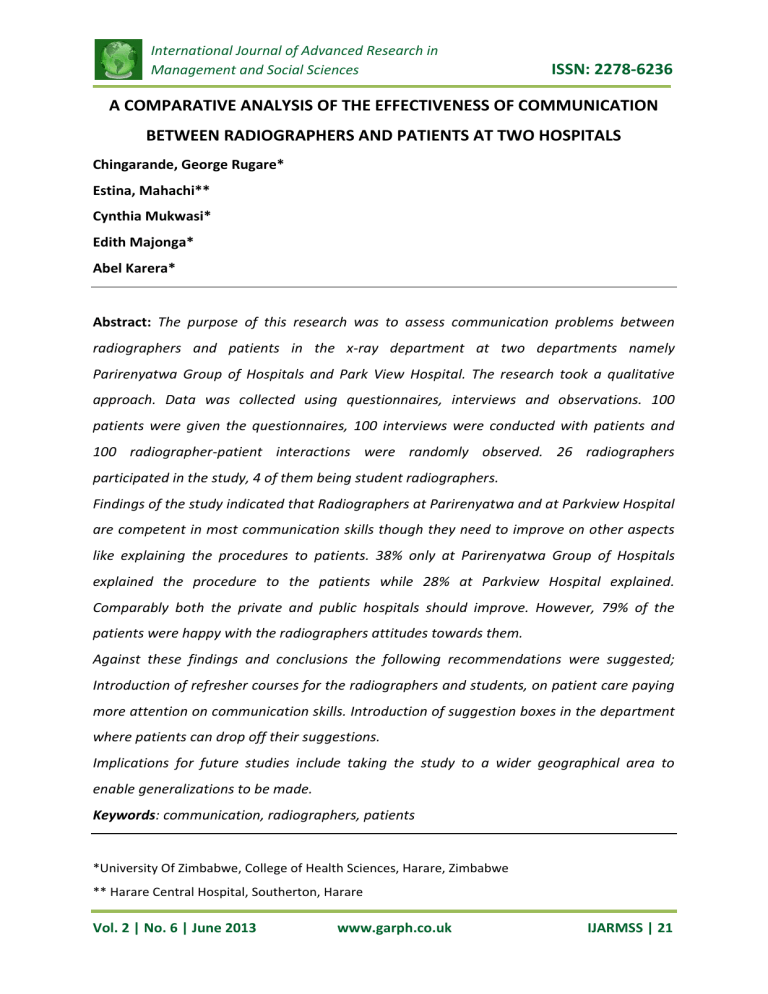
International Journal of Advanced Research in
Management and Social Sciences ISSN: 2278-6236
A COMPARATIVE ANALYSIS OF THE EFFECTIVENESS OF COMMUNICATION
BETWEEN RADIOGRAPHERS AND PATIENTS AT TWO HOSPITALS
Chingarande, George Rugare*
Estina, Mahachi**
Cynthia Mukwasi*
Edith Majonga*
Abel Karera*
Abstract: The purpose of this research was to assess communication problems between radiographers and patients in the x-ray department at two departments namely
Parirenyatwa Group of Hospitals and Park View Hospital. The research took a qualitative approach. Data was collected using questionnaires, interviews and observations. 100 patients were given the questionnaires, 100 interviews were conducted with patients and
100 radiographer-patient interactions were randomly observed. 26 radiographers participated in the study, 4 of them being student radiographers.
Findings of the study indicated that Radiographers at Parirenyatwa and at Parkview Hospital are competent in most communication skills though they need to improve on other aspects like explaining the procedures to patients. 38% only at Parirenyatwa Group of Hospitals explained the procedure to the patients while 28% at Parkview Hospital explained.
Comparably both the private and public hospitals should improve. However, 79% of the patients were happy with the radiographers attitudes towards them.
Against these findings and conclusions the following recommendations were suggested;
Introduction of refresher courses for the radiographers and students, on patient care paying more attention on communication skills. Introduction of suggestion boxes in the department where patients can drop off their suggestions.
Implications for future studies include taking the study to a wider geographical area to enable generalizations to be made.
Keywords : communication, radiographers, patients
*University Of Zimbabwe, College of Health Sciences, Harare, Zimbabwe
** Harare Central Hospital, Southerton, Harare
Vol. 2 | No. 6 | June 2013 www.garph.co.uk IJARMSS | 21
International Journal of Advanced Research in
Management and Social Sciences
INTRODUCTION
ISSN: 2278-6236
Communication is vital to good patient care in any discipline in the health domain and there is a lot that has been written concerning communication problems in the general practice of
Radiology. Communication in medical imaging is a neglected area of research, despite the necessity for good communication if optimum diagnostic images are to be achieved. (Adams and Smith,2003). Interpersonal communication between radiographers and patients plays an important role in the success of radiographic exams. Some of the patients routinely respond differently from the instructions given by the radiographer during exposure, resulting in delays or having to repeat the examination altogether. Ineffective communication during radiological procedures has many ramifications which include poor quality radiographs, inconclusive examinations, patient delays among others. Often radiographic procedures have to be repeated, which in turn increases the radiation dose to which the patient is exposed and escalates the costs of the examination.
This study investigates the effectiveness of communication between radiographers and patients at a public hospital and a privately owned radiology department, both in Harare,
Zimbabwe. The specific objectives were:
1. To establish the prevalence of communication problems involving radiographers and patients in the respective hospitals.
2. To establish the causes of communication problems between radiographers and patients in the two hospitals.
3. To evaluate underlying factors contributing to the incidents of communication problems between radiographers and patients
4. To identify communication problems as perceived by the patient and the radiographers.
METHODOLOGY
The target population for this study was the radiographers and students radiographers at the respective hospitals on one hand and the patients patronizing the hospitals. Since the numbers of radiographers working in both hospitals is very small all the radiographers were enrolled and therefore no special sampling technique was used. Random sampling was used on patients who were available at the time of data collection. Patients who were above the age of 21 years and were literate were taken included in the study. A sample of 100 patients
Vol. 2 | No. 6 | June 2013 www.garph.co.uk IJARMSS | 22
International Journal of Advanced Research in
Management and Social Sciences ISSN: 2278-6236 was obtained; 50 patients were obtained from each hospital. Of the 50; 25 were female and
25 were male.
In the current study triangulation/triaging which refers to the use of multiple methods or perspectives to collect and interpret data about the same phenomena, and converge on an accurate representation of reality was employed (Polit et al,1995) The three measuring tools that were used were observational sheets, interviews and questionnaires. Observations are used when a researcher expects to study behavior, activity and sequence of interactions or the context or the environment in which these behaviours and actions take place (Langford,
2001). In this study, the researcher observed certain attributes of communication such as greetings between the radiographer and the patient, and weather the radiographer introduces him/herself quite well to the patient. Several features classify observations.
These include structure, participation of the researcher and visibility of the researcher
(Wilson 1993). In the current study a structured observation, in the form of an observational checklist was used so as to isolate the few variables. The second research instrument was a questionnaire. Two questionnaires were designed and administered; one to the patients and the other to the radiographers. The questionnaires comprised of both open and closed ended questions.
Structured interviews were conducted with both patients and radiographers as a third research instrument. The participants were first asked to complete the questionnaire and the interviews followed thereafter. Observations were made while the radiological procedure was in progress.
For the purpose of analysis, data related to each instrument was pooled together and presented in the same category. The three categories are: Category A: Observations,
Category B: Questionnaire and Category C: Interviews.
RESULTS
The observation phase of the study considered five observations. These were captured by the following questions: Did the radiographer greet and introduce herself to the patient;
Was the radiological procedure explained to the patient; Did the radiographer probe for feedback from the patient to establish that the patient understood the procedure; Did the radiographer inform the patient when the procedure was commencing; Did the radiographer give information to the patient after the procedure pertaining to where to go
Vol. 2 | No. 6 | June 2013 www.garph.co.uk IJARMSS | 23
International Journal of Advanced Research in
Management and Social Sciences ISSN: 2278-6236 and when to collect results; Was there a language barrier between the radiographer and the patient; Was there noise in the background that could hinder the two parties from understanding one another and Was the radiographer’s voice projection adequate. The summary of the results are presented in Table I below.
Table I: Summary of observations.
Greeting and Introduction
Procedure Explanation
Procedure Commencement explained
Feedback solicited
Post Procedure Explanation
Language Barrier
Noise Barrier
Good Voice Projection
Public Hospital
72%
38%
91%
90%
84%
10%
2%
12%
Private Hospital
80%
28%
95%
86%
94%
4%
0%
12%
Four major factors stand out for their low scores, from the observations. These are procedure explanation, voice projection, language barriers and greetings and introductions.
All the other factors scored above 80%.
RADIOGRAPHERS’ QUESTIONNAIRES RESULTS
The summary of the findings from the radiographers’ questionnaire is presented in Table II below.
Table II: Summary of radiographers’ perceptions.
Prevalence of Communication Problems
Staff Shortage Contributory Factor
Radiographer Lost Poise Faced with the problem
Drugs and Alcohol fuelled the problem
Threatening Behavior
Physical Assault
Sexual Harassment
Verbal Abuse
Public Hospital
100%
64%
6%
38.5%
61%
35%
6%
12%
Private Hospital
100%
21%
6%
16%
6%
0%
0%
4%
All the radiographers at both hospitals reported that communication problems between them and the patients were prevalent. However, the prevalence of the causes of these problems varied between the two hospitals. The radiographers from the public hospital reported more incidences of threatening behavior, sexual harassment, verbal abuse and
Vol. 2 | No. 6 | June 2013 www.garph.co.uk IJARMSS | 24
International Journal of Advanced Research in
Management and Social Sciences ISSN: 2278-6236 physical assault. Furthermore, they explained that most sexual harassment problems were in the form of inappropriate comments directed at female radiographers by male patients.
Alcohol and drug abuse related incidences were also more common at the public hospital.
Six percent (6%) of the radiographers from each hospital reported that they had managed to resolve the communication problems successful without involving third parties. Of those that reported verbal abuse 68% reported that they ignored the abuse, 25% retorted back to the patient and 7% asked for intervention from other radiographers or the security department. All the radiographers that retorted back to the patient were from the public hospital. Responses to threatening behavior ranged from ignoring the behavior (30%), verbal defense (65%), told the patient to stop (60%), and called security (35%). In most cases radiographers combined a number of responses in a single incident. Only 5% of cases of threatening behavior resulted in incident forms being completed and investigated. All cases of assault were reported both to senior staff and security, and 85% of the cases resulted in the completion of incident forms and investigations. The most common response to sexual harassment was rebuking the patient and telling the patient to stop using language that had sexual contortions (89%), followed by reporting the matter to the security and to senior staff (20%). There were no incident forms completed for sexual harassment episodes.
RESPONSES FROM PATIENTS
The summary of the patients’ perceptions on communication problems and their sources are presented in Table III below.
Table III: Patient Perceptions.
Greeting and Introduction
Procedure Explained and understood
Adequate time allocated to communication
Encountered Communication Problems
Patient Satisfaction
Public Hospital
57%
72%
40%
26%
13%
Private Hospital
62%
90%
66%
4%
87%
In all the dimensions of communication evaluated the patients form the private hospital viewed their interactions with radiographers more favorably than those from the public hospitals. The greatest differences were reported in overall satisfaction (13%; 87%),
Vol. 2 | No. 6 | June 2013 www.garph.co.uk IJARMSS | 25
International Journal of Advanced Research in
Management and Social Sciences ISSN: 2278-6236 adequate time allocation (40%; 66%) and prevalence of communication problems (26%;
4%).
INTERVIEW RESULTS
The main findings from the radiographers’ interviews were that the patients were not always co-operative, This sentiment was echoed more often by radiographers from the public hospital compared to radiographers from the private hospitals. When further probed
66% of the radiographers from the public hospital admitted that they could have communicated better and this would have averted the problem or at least prevent it from escalating. Only 7% of the radiographers from the private hospital felt that better communication would have resulted in different outcomes. According the radiographers the underlying factors behind the communication problems included long waiting hours by patients which tends to stretch patient’s patience; psychological problems by both radiographers and patients; emotional burnout among both radiographers and patients and staff shortages which impacted on the radiographers’ workloads and consequently communication time allocated to each patient.
The patients who were interviewed opined that although the radiographers took time to explain the procedures, they did not always understand what was required of them.
Furthermore, there was a tendency by the radiographers to bark instructions from behind the control panel especially in the public hospital. This sometimes acted as a communication barrier. Ninety seven (97%) percent of the interviewed patients expressed the view that the radiographers in the public hospital had attitude problems compared to 7% of the patients from the private hospital who shared this sentiment. It was also reported that the radiographers in the public hospitals seemed to be in a hurry and paid little attention to patient needs.
DISCUSSION
In a six year study (1997-2002), on the root causes of sentinel events in hospitals, the(Joint
Commission on Accreditation of Healthcare Organizations (JCAHO) placed ‘communication’ at the very top of the list of root causes. Both radiology departments in the current study reported a high prevalence of communication problems with all radiographers reporting having experienced communication problems. There were more reports of communication problems from patients patronizing the public hospital compared to their counterparts in
Vol. 2 | No. 6 | June 2013 www.garph.co.uk IJARMSS | 26
International Journal of Advanced Research in
Management and Social Sciences ISSN: 2278-6236 the private hospital. These communication problems are likely to result in increased incidence of sentinel events.
In a similar study among Malaysian patients Thrall (2007) reported patients were properly addressed in about 30% of the cases. In a study at a Fiji hospital Kaushal (2007) reported
“that the procedure was explained to patients by 28% of the Radiographers, clear instructions given to patients by only 18% of the Radiographers and 42% of the radiographers informed the patients what to do after the examination. The patientradiographer interaction was very poor and resulted from communication barriers such as: very minimal time spent with patient, language difference, gender difference, and presence of accompanying relatives hindering examination, longer waiting time and presenting condition of patient. 87% of the patients indicated that the communication was poor.” The current study observed a much higher rate of radiographers greeting patients and introducing themselves. However, during the interviews less patients indicated that they had been greeted by the radiographer. This raises two important issues. Greetings and introductions happen within an existing cultural milieu. In Zimbabwean culture failure to greet is regarded as anathema; thus the importance of greetings and introductions are emphasized both in training and practice. Secondly, some of the patients that the researcher observed being greeted later reported that they had not been greeted by the radiographer. The variance can be explained by selective hearing. The patients may be so engrossed and worried about their illnesses to take notice of the greetings and introductions by the radiographers. It could also be that the patients consider this part of the interaction to be peripheral and of little importance that they hardly notice it. The other explanation could be that the radiographers are so much in a hurry that they pay perfunctory and fleeting attention to greetings and other matters of professional etiquette.
This view is supported by the findings from the interviews and the observation that the radiographers in the public hospital were short staffed and always in a hurry. Wynia and
Matiasek (2006) emphasize the importance of patient centric communication. In the current study staff shortages seem to be detracting from patient centric communication as evidenced by the observation that often radiographers bark instructions from behind the control panel, especially in the public hospital.
Vol. 2 | No. 6 | June 2013 www.garph.co.uk IJARMSS | 27
International Journal of Advanced Research in
Management and Social Sciences ISSN: 2278-6236
Although both hospitals report a high prevalence of communication problems, there are very wide disparities in the nature of these problems. The public hospital reported by far higher incidences of physical assaults, sexual harassment, verbal abuse, threatening behavior, alcohol and drug related incidences and high patient dissatisfaction. It is also noteworthy that all the radiographers who retorted back to the patients when provoked were form the public hospital. This cannot be attributable to laws of chance and coincidence. In Zimbabwe, one’s choice to access services at a private radiology department or public hospital department is dictated by one’s socio-economic status. The socioeconomic status is in turn to a large extent dependent on one’s level of education. Kholberg
(1973) argues that there are two types of curricula in education namely the formal curricula and the hidden curricula. The formal curricula consists of syllabi and official documents produced by the education authorities, while the hidden curricula is a set of values, traditions and beliefs that people are socialized into during their school years. The hidden curricula have great influence on the moral development of people.
The behavior of the patients in the public hospitals towards the radiographers is clearly a product of their moral development and socialization. The differences in the typology of communication problems faced by radiographers in the public and private hospitals in this study can therefore be explained by the hidden curricula at the centre of the moral education of the respective groups of patients. It would seem that the moral education of the two sets of patients is very different; thus leading to different behavioral dispositions when faced with challenging situations in the hospitals.
In conclusion the communication problems experienced between patients and radiographers are multi-faceted and stem from various factors. There are institutional factors such as background noise and staff shortages resulting in long queuing time and consequent patient and radiographer irritability. There are also personal factors such as language barriers and the patients’ physical and psychological states. Finally, there are also issues of moral development whose roots can be found in the socio-economic status and the hidden curricula. Torres (1998) argues that effective communication begins when the radiographer possess a degree of self-knowledge. The same thesis is applicable to patients.
Attempts to address communication problems between radiographers and patients should take into considerations the multifaceted nature of the problem.
Vol. 2 | No. 6 | June 2013 www.garph.co.uk IJARMSS | 28
International Journal of Advanced Research in
Management and Social Sciences
REFERENCES
ISSN: 2278-6236
1.
Adams J Phd & Smith T (2003) Quantitative Methods in Radiography Research: A proposed framework .
2.
Donnly, L.F.and Strife, L.J. (2011). Effective communication in Radiology , AJR Am ,
Roentgenol;1398-1401.
3.
Joint Commision On Accreditation In Health Care Organisations (2011) http://www.joint commission.org/patient safety/rationalpatientssafetygoods/07 bhcnpsgs,htm.
4.
Kaushal, K. (2007). Effectiveness of communication between radiographers and patients at C. W. M. H. Radiology Department of, Fiji . Biomedical Imaging and
Intervention Journal; Vol. 3. (1). Pp12-225.
5.
Kholberg, L. (1973). Moral education and the new social studies . Social Education,
37, 369-375.
6.
Langford, L. (2001): Clinical Nursing Research. Charpman and Hall,Carlifonia,USA.
7.
Polit, D.F & Hungler, B.P (1995): Nursing Research Principles and Methods ,3 rd
Edition, J.B. Lippincott Company, USA.
8.
Smith, M.(1993 ). Assisting with patient care . Mosby.
9.
Thrall, J. (2007).
Re-inventing radiology in a digital age.
Radiology March 1,
2007 242:3 671-682.
10.
Torres, L.S,, Norcutt, T.A. and Duffon, A.G. (1993) Basic Medical techniques and patient care in imaging technology.
11.
Wilson, G. (1990). The Hospital Health Services, Western Infirmary, London, UK.
12.
Wynia, M. and Martiasek,J.(2006).Promising Practices for patient centered communication with vulnerable population: Common Wealth Fund.
Vol. 2 | No. 6 | June 2013 www.garph.co.uk IJARMSS | 29

